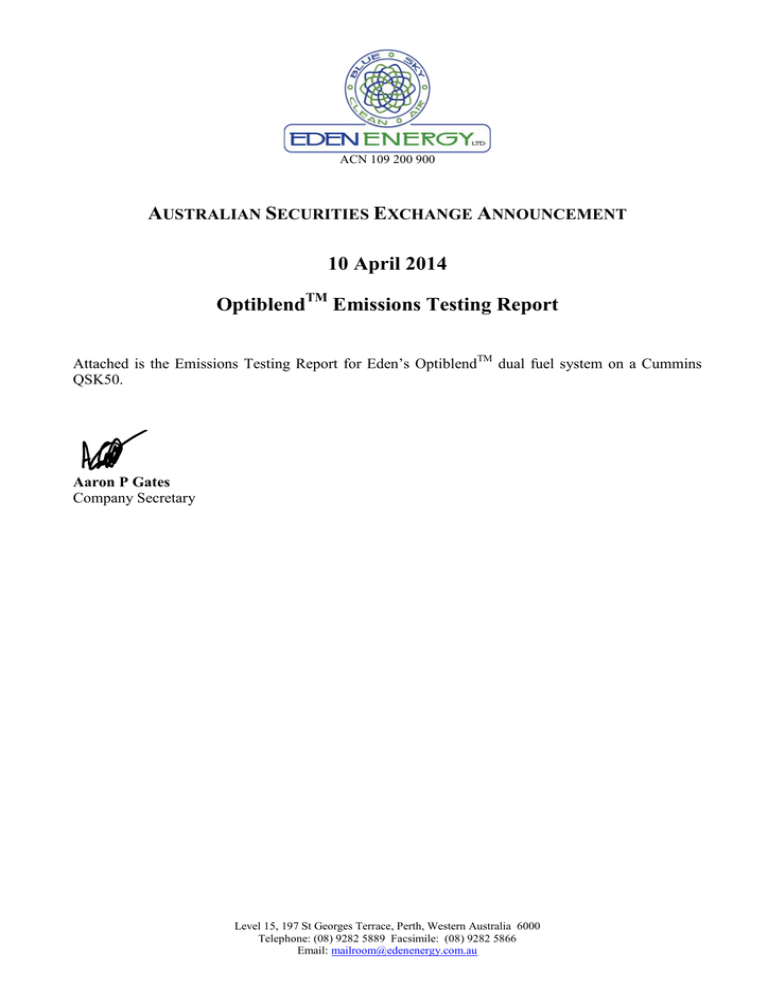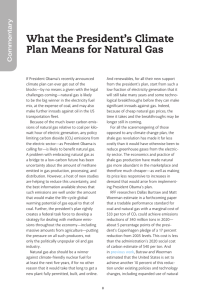Emissions Testing on Eden\`s Optiblend Dual Fuel
advertisement

ACN 109 200 900 AUSTRALIAN SECURITIES EXCHANGE ANNOUNCEMENT 10 April 2014 OptiblendTM Emissions Testing Report Attached is the Emissions Testing Report for Eden’s OptiblendTM dual fuel system on a Cummins QSK50. Aaron P Gates Company Secretary Level 15, 197 St Georges Terrace, Perth, Western Australia 6000 Telephone: (08) 9282 5889 Facsimile: (08) 9282 5866 Email: mailroom@edenenergy.com.au Cummins QSK50 (Tier II) Drilling Power Module OptiBlend™ Dual Fuel Emissions Testing Report Background The OptiBlend™ Heavy Duty Dual Fuel System by Hythane Company, a wholly owned subsidiary of Eden Energy Ltd, is an innovative dual fuel/bi-fuel retrofit technology designed to withstand a wide range of applications, including diesel engines operating in harsh environments. This economical kit displaces roughly half of the diesel fuel with natural gas, without modifications to the internal components or OEM engine management system. The OptiBlend System dramatically lowers operational costs, increases backup runtime capacity, and reduces NOx, CO2 and PM emissions. The addition of a diesel oxidation catalyst (DOC) ensures that the CO and HC emissions are also reduced to a level below the applicable standards. The Heavy Duty OptiBlendTM system was designed with input from multiple industries and applications, making it capable of handling stationary generators and pumps, electrical power generation on drilling rigs, and mobile hydraulic fracturing pumps. More information is available at http://www.hythane.net. The long-term trend of rising diesel fuel costs combined with the relatively recent and significant drop in natural gas costs, which seems to be sustainable for the foreseeable future, has led to an interest by many industries to use natural gas in place of diesel wherever possible. Although non-transportation uses represent a relatively small section of the total diesel fuel consumption of the US, oil and gas well drilling and servicing is a particularly intense area of use. Thousands of horsepower are applied around the clock for well drilling, and tens of thousands of horsepower are used for days or weeks at a time for hydraulic fracturing pumps. Displacing half of this diesel combustion with natural gas is a rare opportunity for industry to reduce costs and emissions with the same equipment. For aftermarket retrofit equipment for on-highway engines, there is a streamlined path to emissions compliance using EPA’s “Verify” process. Likewise, for stationary applications, 40 CFR 60.4211(g) provides a method for initial and follow-up field emissions tests to prove compliance. However, electrical power modules for drilling rigs are considered “mobile, nonroad” applications for emissions regulations. There are no current EPA procedures for emissions compliance for these engines, other than full certification by the OEM. Recent guidance from EPA personnel indicates that the EPA is aware of this “hole” in the regulations for aftermarket equipment applied to mobile non-road engines, but any amendments to the CFR to cover these applications are at least a few years away. Since the OEM is not interested in pursuing full (re)certification (or CARB certification) of their engine with Hythane Company’s equipment, Hythane Company has performed laboratory emissions testing that would establish a “reasonable basis” under the broad definitions of the EPA’s Memorandum 1A, in order to prove that the dual fuel retrofit equipment results in emissions that are compliant with the applicable standards. Laboratory The engine was tested in the chassis cell of the Texas Center for Clean Engines, Emissions and Fuels (TxCEF), a center for comprehensive research, development and testing of advanced power-train, renewable or alternative fuels and emission control systems for local, state and federal governments as well as the energy, engine and emission control industries. The center is staffed with engineers and researchers from the University of Houston Departments of Chemical and Biomolecular Engineering and Mechanical Engineering. Research projects incorporate involvement of faculty and graduate students from many additional departments within this Tier One research university. The center has research capabilities spanning bench scale testing of emerging technologies to full scale testing of heavy duty diesel vehicles. The engine testing was performed from February 10th to 19th, 2014, using diesel fuel and dual fuel (natural gas and diesel fuels), and the pre- and post-catalyst emissions were measured using EPA-approved equipment. Test Engine The test engine was a new-production Cummins QSK50 engine/generator set (genset) intended for subsequent service in the USA. The engines was sold by Cummins with an OEM Tier II emissions certification, using banked credits for current emissions compliance. The QSK50 four-stroke turbocharged diesel engine was retrofitted with a diesel oxidation catalyst (DOC) and an aftermarket OptiBlend dual fuel conversion system manufactured by Hythane Company. Detailed engine specifications are listed in Table 1. Table 1. Engine Specifications Engine No. Model Date of Manufacture Advertised Power EPA Family ECS Emission Level Genset Package Serial No. Generator ID Generator Make/Model Package Build Date Rated Voltage/KW/KVA/Freq. Beginning Catalyst Hours Beginning Engine Hours 33198774 QSKTA50-CE 11-SEP-2013 1480 HP (1104 KW) AT 1200 RPM ACEXL060.AAD DDI ECM TC CAC EPA Tier II (banked credits used for 2014 compliance) 0090071 33781-02 Kato Engineering 6P6-3300, AA27647030 4-DEC-2013 600V / 1050 KWE AT 0.7 P.F. / 1751 KVA / 60 HZ 8 20 Test Fuels Ultra-low sulfur petroleum diesel fuel (ULSD #2 non-road) was used as a base fuel, which was provided by Sun Coast Resources. Vaporized liquid natural gas fuel (NG) was provided by Thigpen Energy. The properties of the ULSD were analyzed by a nationally-recognized engineering laboratory based on American Society of Testing and Materials (ASTM) standard. The properties of the natural gas were provided by Clean Energy. Test Cycle The laboratory “zero-hour” emissions testing is similar to the option listed in 40 CFR 60.4211(g) for stationary engines, which is a very similar application to this genset skid. The tests took place in accordance with the latest Code of Federal Regulations (CFR), Title 40, Part 1065 standards (where applicable), using the ISO 8178 D2 test cycle (constant speed, 5-mode, steadystate test). This test cycle has 5 torque loads (100, 75, 50, 25 and 10%) at the rated speed (1200 rpm). Testing of the genset required the use of a resistive load bank (Avtron Model K875AD29650-11, S/N 89) and 600V-to-480V transformer. The real power of the generator was measured with an AC&M Power Meter, Model PM96-32106. The engine power, used for brake-specific emissions calculation, was calculated from the electrical power using the generator manufacturer’s efficiency data. The genset electrical power (and therefore the engine horsepower) for each mode was at the same level for both diesel-only, and diesel and natural gas test cycles. Table 2 provides the required and measured loads of each mode per ISO 8178. The list of tests is given in Table 3. Table 2. Example of Testing Modes Mode 1 Mode 2 Mode 3 Mode 4 Mode 5 Weight Factor 0.05 0.25 0.3 0.3 0.1 % Load 100 75 50 25 10 Measured % Load* 101 76 48 24 9 Measured Load kWe* 1065 813 513 256 102 *Specific loads were limited by the load switch combinations available on the load bank. Table 3. Overview of Emissions Testing of QSK50 Test Condition 1 2 3 Fuel ULSD ULSD ULSD & NG Test Name DBC DAC DGAC Sampling position Pre-Catalyst Post-Catalyst Post-Catalyst Emissions Measurement The equipment used is shown in Table 5. In order to verify the accuracy of emissions measurements, multiple tests were conducted for each test condition. Also, all the required checks and calibrations on the analyzers were performed before and after each test run. Further details of the test cell equipment can be supplied upon request. Table 5. Analysis Equipment Device MEXA 7100D AVL AMAI60 AVL SPC 472 MKS-2030 Dwyer S-type Pitot tube Purpose CO2, CO, NOx THC, CH4 PM H2O Exhaust Flowrate All the raw emissions data were taken over the last 60 seconds of each mode and within +/- 5 s of the end of PM sampling. The CO2, CO and NOx were corrected from dry to wet basis. NOx was further corrected for engine intake air temperature and relative humidity. NMHC was calculated using the raw values along with the combined penetration fraction and response factor of ethane and methane for the AVL FID analyzer. Results The data were used to calculate brake specific emissions per ISO 8178 or CFR Title 40, part 1065, where applicable. The CO2 had coefficients of variation lower than 3%, which demonstrates repeatability in tests using the same fuel. The averaged emissions reductions, relative to a diesel-only baseline with no catalyst, are provided in Table 6. Table 6. Average Brake Specific Emissions Reductions DAC (diesel post-cat) DGAC (dual fuel post-cat) CO2 N/A -10.9% CO -97.7% -93.5% NOx N/A -16.1% NMHC -90.9% -99.9% PM -16.2% -38.8% Discussion Brake specific CO2 emissions were reduced from diesel-only to diesel and natural gas by 10.9%. Methane, the primary constituent of natural gas, has a molecular composition with a higher hydrogen-to-carbon ratio than diesel fuel. Therefore, for the same energy, less CO2 and more water is produced from natural gas combustion. Engine-out Carbon Monoxide (CO) rises significantly when the natural gas is used, however, final CO emissions are reduced by the diesel oxidation catalyst a total of 93.5% relative to the diesel baseline (which has no stock catalyst). When natural gas is not available, diesel-only operation will result in 97.7% lower CO due to the catalyst retrofit. Dual fuel NOx values were reduced 18.3%, probably due to a reduction in peak cylinder temperatures – the catalyst has little to no effect on NOx levels in the oxidizing environment of lean diesel engine exhaust. The non-methane hydrocarbon emissions were very low, and they were reduced further with the diesel oxidation catalyst. Particulate matter (PM) emissions were also low throughout all of the tests, but the catalyst caused a reduction of 16.2%, likely due to the burnoff of the wet SOF (soluble organic fraction). Dual fuel operation further reduced the PM levels, for a total reduction of 38.8%.



